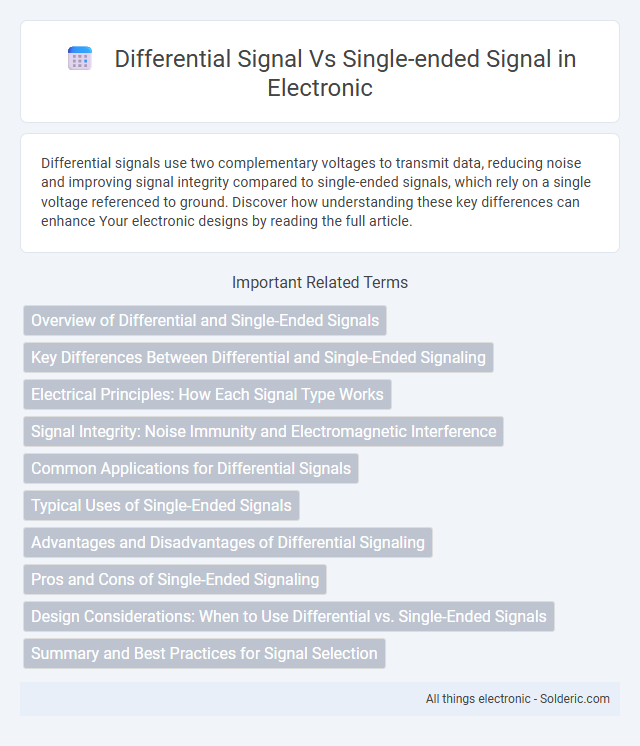Differential signals use two complementary voltages to transmit data, reducing noise and improving signal integrity compared to single-ended signals, which rely on a single voltage referenced to ground. Discover how understanding these key differences can enhance Your electronic designs by reading the full article.
Comparison Table
| Feature | Differential Signal | Single-Ended Signal |
|---|---|---|
| Signal Transmission | Uses two complementary signals for each data line | Uses one signal and a common ground reference |
| Noise Immunity | High noise immunity due to noise cancellation | Lower noise immunity; susceptible to ground noise |
| Signal Integrity | Better at maintaining integrity over long distances | Signal degrades faster over distance |
| Bandwidth | Supports higher bandwidth with less interference | Limited bandwidth due to noise and interference |
| Power Consumption | Generally higher power consumption | Lower power consumption |
| Circuit Complexity | More complex transmitter and receiver design | Simpler and cheaper design |
| Common Applications | USB, Ethernet, HDMI, PCIe | Audio signals, simple sensors, TTL logic |
| Cost | Typically higher due to complexity | Lower cost in hardware implementation |
Overview of Differential and Single-Ended Signals
Differential signals transmit data using two complementary voltage lines, improving noise immunity and signal integrity in high-speed and long-distance communications. Single-ended signals rely on a single voltage line referenced to ground, making them simpler but more susceptible to electromagnetic interference and signal degradation. Differential signaling is preferred in environments demanding robust data transmission, while single-ended signaling suits low-cost and short-distance applications.
Key Differences Between Differential and Single-Ended Signaling
Differential signaling transmits data using two complementary voltage signals, enhancing noise immunity and reducing electromagnetic interference compared to single-ended signaling, which uses one signal wire referenced to ground. Key differences include improved signal integrity and higher noise rejection in differential signaling, making it ideal for high-speed and long-distance communication, whereas single-ended signaling is simpler and cost-effective but more susceptible to noise. The differential approach also enables better common-mode noise cancellation and lower crosstalk levels, critical in complex electronic systems and data transmission environments.
Electrical Principles: How Each Signal Type Works
Differential signals transmit data by sending two complementary voltages across a pair of wires, allowing the receiver to measure the voltage difference, which reduces noise and electromagnetic interference. Single-ended signals use one wire referenced to a common ground, making them more susceptible to noise and signal degradation over longer distances. Understanding these electrical principles helps you choose the right signaling method for reliable data communication in your system.
Signal Integrity: Noise Immunity and Electromagnetic Interference
Differential signals offer superior noise immunity compared to single-ended signals by using two complementary voltage lines, allowing common-mode noise to be effectively canceled out. This improves signal integrity in electrically noisy environments and reduces susceptibility to electromagnetic interference (EMI). Single-ended signals, referenced to a common ground, are more prone to signal degradation from external noise sources and EMI, making differential signaling the preferred choice for high-speed and high-precision applications.
Common Applications for Differential Signals
Differential signals are widely used in high-speed data communication interfaces such as USB, Ethernet, and HDMI to reduce electromagnetic interference and crosstalk by transmitting two complementary signals. They are essential in industrial automation and instrumentation systems where accuracy and noise immunity are critical. Audio and video transmission systems also rely on differential signaling to maintain signal integrity over long cable runs.
Typical Uses of Single-Ended Signals
Single-ended signals are commonly used in low-speed, short-distance communication such as audio connections, analog sensors, and simple data lines where noise immunity is less critical. These signals transmit data with reference to a common ground, making them cost-effective and easier to implement in consumer electronics and basic instrumentation. Typical examples include RCA audio cables, TTL logic signals, and HDMI DDC communication lines.
Advantages and Disadvantages of Differential Signaling
Differential signaling offers advantages such as enhanced noise immunity, as it uses two complementary signals that cancel out electromagnetic interference, making it ideal for long-distance and high-speed data transmission. It also reduces electromagnetic interference (EMI) emissions, improving signal integrity in complex environments. However, differential signaling requires more complex circuitry and additional wiring, increasing cost and design complexity compared to single-ended signaling.
Pros and Cons of Single-Ended Signaling
Single-ended signaling offers simplicity in design and lower cost due to its use of a single conductor and ground reference but is more susceptible to electromagnetic interference (EMI) and noise. It typically experiences greater signal degradation over longer distances, limiting its effectiveness in high-speed or long-range communication. Single-ended signals are easier to implement but provide lower noise immunity compared to differential signaling.
Design Considerations: When to Use Differential vs. Single-Ended Signals
Differential signals offer superior noise immunity and are ideal for high-speed or long-distance data transmission where signal integrity is critical, particularly in environments with significant electromagnetic interference (EMI). Single-ended signals are suitable for short distances and low-frequency applications where simplicity and cost-effectiveness are prioritized, such as in basic sensor or audio connections. Design considerations include the trade-offs between complexity, cost, and performance requirements, with differential signaling preferred for robust communication and single-ended for straightforward, low-noise environments.
Summary and Best Practices for Signal Selection
Differential signals provide superior noise immunity and improved signal integrity by transmitting two complementary voltages, making them ideal for high-speed and low-noise environments compared to single-ended signals, which use a single voltage referenced to ground. Best practices for signal selection include choosing differential signaling for critical, high-frequency applications to reduce electromagnetic interference (EMI) and crosstalk, while single-ended signaling suits simpler, low-frequency circuits with less stringent noise requirements. Careful consideration of layout, impedance matching, and proper termination enhances performance regardless of the chosen signaling method.
Differential signal vs single-ended signal Infographic

 solderic.com
solderic.com